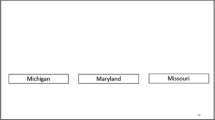Abstract
Stimulus overselectivity is widely accepted as a stimulus control abnormality in autism spectrum disorders and subsets of other populations. Previous research has demonstrated a link between both chronological and mental age and overselectivity in typical development. However, the age at which children are developmentally ready to respond to discriminations involving simultaneous multiple cues has not been established. Thirty-seven typically developing preschoolers completed a task requiring response to simultaneous cues (color and shape) to establish the age at which typically developing children can successfully respond to multiple cues. Results demonstrate that typically developing children under 36 months of age have difficulty responding to multiple cues. Implications for behavioral treatment for autism are discussed.




Similar content being viewed by others
References
Bailey, S. L. (1981). Stimulus overselectivity in learning disabled children. Journal of Applied Behavior Analysis, 14, 239–248.
Bickel, W. K., Stella, M. E., & Etzel, B. C. (1984). A reevaluation of stimulus overselectivity: Restricted stimulus control or stimulus control hierarchies. Journal of Autism and Developmental Disorders, 14, 137–157.
Brack, U. B. (2001). Überselektive Wahrnehmung bei retardierten Kindern. Göttingen: Hogrefe.
Bricker, D., & Squires, J. (1999). Ages & stages questionnaires: A parent-completed, child monitoring system. Baltimore: Paul H. Brookes.
Corsello, C. (2005). Early intervention in autism. Infants and Young Children, 18, 74–85.
Dickson, C. A., Wang, S. S., Lombard, K. M., & Dube, W. V. (2006). Overselective stimulus control in residential school students with intellectual disabilities. Research in Developmental Disabilities, 27, 618–631.
Dube, W. V., & McIlvane, W. J. (1997). Reinforcer frequency and restricted stimulus control. Journal of the Experimental Analysis of Behavior, 68, 303–316.
Eimas, P. D. (1969). Multiple-cue discrimination learning in children. Psychological Record, 19, 417–424.
Fairbank, D., Powers, A., & Monaghan, C. (1986). Stimulus overselectivity in hearing-impaired children. Volta Review, 88, 269–278.
Fisher, M. A., & Zeaman, D. (1973). An attention-retention theory of retardate discrimination learning. In N. B. Ellis (Ed.), International reivew of research in mental retardation (Vol. 6, pp. 171–251). New York: Academic Press.
Gersten, R. M. (1983). Stimulus overselectivity in autistic, trainable mentally retarded, and non-handicapped children: Comparative research controlling chronological (rather than mental) age. Journal of Abnormal Child Psychology, 11, 61–75.
Hale, G. A., & Morgan, J. S. (1973). Developmental trends in children’s component selection. Journal of Experimental Child Psychology, 15, 302–314.
Huguenin, N. H. (1997). Employing computer technology to assess visual attention in young children and adolescents with severe mental retardation. Journal of Experimental Child Psychology, 65, 141–170.
Katoh, T., & Kobayashi, S. (1985). A behavior analysis study on auditory discrimination learning in autistic children: Analysis of responses to speech and nonspeech sounds. Japanese Journal of Special Education, 23, 35–46.
Koegel, R. L., & Wilhelm, H. (1973). Selective responding to the components of multiple visual cues by autistic children. Journal of Experimental Child Psychology, 15, 442–453.
Kovattana, P. M., & Kraemer, H. C. (1974). Response to multiple visual cues of color, size, and form by autistic children. Journal of Autism and Childhood Schizophrenia, 4, 251–261.
Landa, R. J., Holman, K. C., & Garret-Mayer, E. (2007). Social and communication development in toddlers with early and later diagnosis of autism spectrum disorders. Archives of General Psychiatry, 64, 853–864.
Lovaas, O. I., Koegel, R. L., & Schreibman, L. (1979). Stimulus overselectivity in autism: A review of research. Psychological Bulletin, 86, 1236–1254.
Lovaas, O. I., Schreibman, L., Koegel, R. L., & Rehm, R. (1971). Selective responding by autistic children to multiple sensory input. Journal of Abnormal Psychology, 77, 211–222.
McHugh, L., & Reed, P. (2007). Age trends in stimulus overselectivity. Journal of the Experimental Analysis of Behavior, 88, 369–380.
Ploog, B. O. (2010). Stimulus overselectivity four decades later: A review of the literature and its implications for current research in autism spectrum disoder. Journal of Autism and Developmental Disorders, 40, 1332–1349.
Ploog, B. O., & Kim, N. (2007). Assessment of stimulus overselectivity with tactile compound stimuli in children with autism. Journal of Autism and Developmental Disorders, 37, 1514–1524.
Rincover, A., & Ducharme, J. M. (1987). Variables influencing stimulus overselectivity and “tunnel vision” in developmentally delayed children. American Journal of Mental Deficiency, 91, 422–430.
Schneider, C., & Salzberg, C. L. (1982). Stimulus overselectivity in a match-to-sample paradigm by severely retarded youth. Analysis and Intervention in Developmental Disabilities, 2, 273–304.
Schover, L. R., & Newsom, C. (1976). Overselectivity, developmental level, and overtraining in autistic and normal children. Journal of Abnormal Child Psychology, 4, 289–298.
Schreibman, L. (1975). Effects of within-stimulus and extra-stimulus prompting on discrimination learning in autistic children. Journal of Applied Behavior Analysis, 8, 91–112.
Schreibman, L., Kohlenberg, B. S., & Britten, K. R. (1986). Differential responding to content and intonation components of a complex auditory stimulus by nonverbal and echolalic autistic children. Analysis and Intervention in Developmental Disabilities, 6, 109–125.
Schreibman, L., & Lovaas, O. I. (1973). Overselective responding to social stimuli by autistic children. Journal of Abnormal Psychology, 1, 152–168.
Stahmer, A. C., Suhrheinrich, J., Reed, S., Vattuone, C., & Schreibman, L. (2009). Use of pivotal response teaching in community classrooms serving children with autism. Paper presented at the annual meeting of the Insitute for Educational Sciences, Washington, D.C.
Wilhelm, H., & Lovaas, O. I. (1976). Stimulus overselectivity: A common feature in autism and mental retardation. American Journal of Mental Deficiency, 81, 26–31.
Acknowledgments
This research was supported by the Institute of Educational Sciences, research grant R324B070027. The authors would like to thank Brooke Kellison for her assistance in conducting the discrimination learning assessment and Paul Reed for his assistance with stimuli creation, as well as the families and children who participated in the study.
Author information
Authors and Affiliations
Corresponding author
Additional information
This research formed part of the first author’s doctoral dissertation, which was conducted under the supervision of the second and fourth authors at University of California, San Diego.
Rights and permissions
About this article
Cite this article
Reed, S.R., Stahmer, A.C., Suhrheinrich, J. et al. Stimulus Overselectivity in Typical Development: Implications for Teaching Children with Autism. J Autism Dev Disord 43, 1249–1257 (2013). https://doi.org/10.1007/s10803-012-1658-x
Published:
Issue Date:
DOI: https://doi.org/10.1007/s10803-012-1658-x




